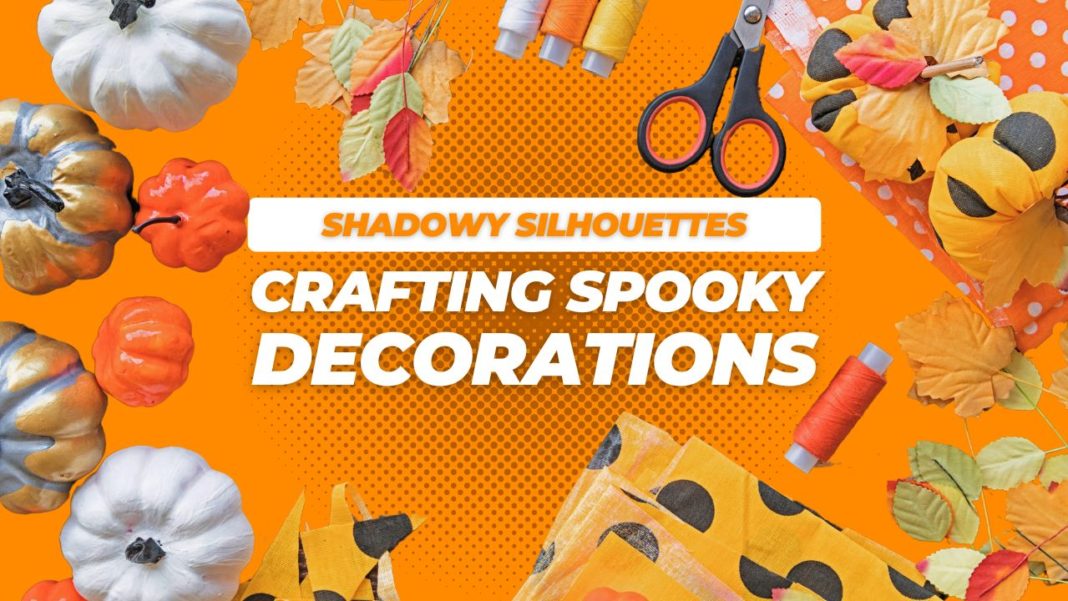Introduction to Spooky Crafting
As the leaves turn and the nights draw in, there’s no better way to warm up the chill of the Halloween season than by diving into some delightful DIY projects. Spooky crafting isn’t just about decorating; it’s an opportunity to laugh, share stories, and create memories with someone special. Whether it’s your first date or your fiftieth, making DIY Halloween decorations together can add a playful and creative twist to your relationship. So, gather your crafting supplies, cosy up, and prepare to transform simple materials into shadowy silhouettes that will cast a spell over your Halloween celebrations.
someone special. Whether it’s your first date or your fiftieth, making DIY Halloween decorations together can add a playful and creative twist to your relationship. So, gather your crafting supplies, cosy up, and prepare to transform simple materials into shadowy silhouettes that will cast a spell over your Halloween celebrations.
Choosing Your Designs
Selecting the perfect designs for your spooky silhouettes is a crucial step that can enhance the fun and ensure a successful crafting experience. Whether you lean towards classic Halloween figures like eerie witches soaring across the moon, ghastly ghosts, or opt for more unconventional symbols like eerie old trees or whimsical fairy silhouettes, the key is to match the designs with the interests and skill levels of both partners.
Tips for Choosing the Right Designs
Consider Skill Levels
If one of you is more adept with scissors, choose designs that cater to varying levels of complexity. Simple silhouettes like bats or ghosts can be satisfying for beginners, while intricate designs like haunted houses or skeletal trees might offer a rewarding challenge for more experienced crafters.
Align with Interests
Discuss what themes you both enjoy. If one loves horror movies, perhaps a silhouette of a famous horror icon would be exciting. If you enjoy fantasy, silhouettes of mythical creatures can add a unique twist to your décor.
Size Matters
Consider the scale of your project. Larger silhouettes might be simpler to cut but harder to display, whereas smaller ones require more precision but can be more versatile in decorating.
Template or Freehand
Decide whether to use templates or draw designs freehand. Templates can be a great help, especially for complex designs or if you’re short on time. Many websites offer free downloadable patterns that you can print directly onto your crafting material.
Materials and Preparation
Creating stunning spooky silhouettes requires a few basic materials, most of which you might already have at home. Here’s what you’ll need to gather before you start:
Essential Materials
- Black Paper: Thick construction paper or cardstock works best for durability and opacity.
- Scissors: A sharp pair will make cutting out intricate designs much easier.
- Pencils and Erasers: For sketching designs onto your paper or tracing from templates.
- Tracing Items: If using templates, transparent tracing paper or a light tracing table can help transfer designs accurately.
- Tape or Adhesive: To secure your silhouettes in place once they are cut out.
- Light Sources: Small candles (real or LED), fairy lights, or a lamp to backlight your silhouettes for that eerie glow.
Preparing Your Workspace
Clear Space: Ensure your crafting area is spacious and clear of unnecessary clutter. A large table or a flat surface will give you ample space to spread out your materials.
Lighting: Good lighting is crucial. If natural light is not sufficient, set up a desk lamp to illuminate your workspace without creating glare.
Safety First: If you’re using candles for lighting your silhouettes, make sure the area is safe for open flames, or opt for battery-operated candles as a safer alternative.
Setting the Mood
Music and Films
To really get into the spirit of Halloween, play some spooky music in the background, or have a classic Halloween film playing softly. This can make your crafting session even more enjoyable and immersive.
Step-by-Step Crafting Guide
Creating DIY spooky silhouettes can be an enjoyable and creative activity. Here’s how to do it:
Step 1: Select and Prepare Your Design
Choose Your Design
Select a template or draw your own design on a piece of paper. Choose something that you both are excited about and fits your skill level.
Transfer the Design
Place the tracing paper over your design. If using a template, print it and secure it on top of the black paper with tape. Trace the outline with a pencil.
Step 2: Cut Out Your Silhouette
Cutting
Using sharp scissors, carefully cut along the traced lines. Take your time with intricate parts to ensure your silhouette has clean, crisp edges.
Step 3: Refine Your Silhouette
Trimming
Check your silhouette for any rough edges or areas that didn’t quite get cut out properly. Use smaller craft scissors or a craft knife to make any necessary corrections.
Step 4: Prepare for Display
Mounting
Decide how you want to display your silhouette. If placing it against a window, you might use double-sided tape to stick it directly onto the glass. For a standing display, consider mounting it on a sturdier backing that can be propped up.
Step 5: Set Up Lighting
Backlighting
Position a light source behind your silhouette to create a spooky shadow effect. Experiment with different distances and angles until you achieve the desired spooky effect.
Step 6: Final Placement
Decorating: Place your silhouettes around your home. Windows are perfect as they provide a natural backlight during the day and can be seen from outside. Alternatively, set them up against walls in dimly lit corners for a more subtle effect.
Additional Tips
Be Patient
Some designs may require more finesse, so take your time to achieve the best result.
Work Together
Share tasks such as tracing, cutting, and setting up, making it a truly collaborative effort.
Setting the Scene
Once you’ve crafted your shadowy silhouettes, the next step is to display them in a way that truly brings out their spooky charm. Here are some creative ideas for positioning and lighting your decorations to create an enchanting, eerie atmosphere:
Window Wonders
Back-Lighting
Place silhouettes against the inside of a window and use the natural backlight of the outside light to create a stark contrast. This makes the silhouettes highly visible to both indoor onlookers and passersby outside.
Curtains and Blinds
Use sheer curtains or partially closed blinds to diffuse the light softly, which can add a mysterious or ghostly effect.
Candlelit Displays
Safe Lighting
Arrange battery-operated LED candles behind the silhouettes to illuminate them with a flickering glow. This is safer than using real candles and just as effective at creating a haunting vibe.
Groupings
Cluster different silhouettes together, varying their sizes and shapes to create a dynamic tableau. The moving shadows will enhance the spooky effect.
Wall and Mantelpiece Arrangements
Gallery Wall
Treat your silhouettes like art and create a Halloween-themed gallery wall. Combine them with framed Halloween prints or quotes to fill out the space.
Mantelpiece Vignette
Arrange smaller silhouettes on a mantelpiece with other Halloween decorations such as mini pumpkins, cobwebs, and antique books for a themed display.
Lighting Techniques
Spotlighting
Use spotlights or directional lamps to cast dramatic shadows from your silhouettes onto the walls or ceiling.
Coloured Lights
Employ coloured lights like orange, green, or purple to wash your silhouettes in Halloween hues, intensifying the eerie atmosphere.
Outdoor Displays
Garden Ghosts
If you have a garden or an outdoor area, place larger silhouette figures among the foliage to surprise and delight trick-or-treaters or guests.
Pathway Markers
Line your walkway with small, lighted silhouettes to create a guided path that leads visitors to your door through a spooky scene.
Setting Up the Room
Ambient Sound
Enhance the mood with ambient sounds like howling wind, creaking doors, or distant thunder. Soundtracks or sound effects can be played in the background to complement the visual spookiness.
Theme Consistency
Keep a consistent theme throughout the room. If your silhouettes are gothic, extend this style to other decorations; if they’re more whimsical, keep the lighter, fun vibe going with your other decor.
Reflection and Bonding
The beauty of engaging in a DIY project like creating spooky silhouettes isn’t just in the charming decorations you’ve crafted together; it’s also in the shared moments of creativity and collaboration. Such activities can significantly enhance communication and deepen bonds within a relationship. As you reflect on this crafting experience, consider the following:
Discuss the Process
Take a moment to talk about what each of you enjoyed most during the crafting session. Was it the initial design selection, the act of cutting out shapes, or the final step of displaying your work? This can help you understand each other’s creative preferences and strengths.
Share Learnings
What did you learn about each other that you didn’t know before? Perhaps one of you displayed an unexpected artistic flair or a knack for meticulous detail. These revelations can bring delight and appreciation for each other’s unique traits.
Evaluate Teamwork
Consider how well you worked together to accomplish this project. Did you find it easy to agree on decisions, or did you encounter any challenges? Discussing this can improve how you tackle joint activities in the future, reinforcing your teamwork and communication skills.
Future Projects
If you enjoyed this experience, plan for future DIY dates. They can be seasonal, such as Christmas or Easter crafts, or something completely different like building a piece of furniture or gardening together. This not only gives you something to look forward to but also builds a tradition of collaboration and creativity in your relationship.
Capture the Moment
Take photos of your creations or of you both during the process. These can serve as wonderful reminders of the fun and affection shared during these moments.
By taking the time to reflect on and discuss these aspects, you not only cherish the memories made but also set the groundwork for future shared experiences. Projects like these are not just about making decorations; they’re about crafting lasting connections.






